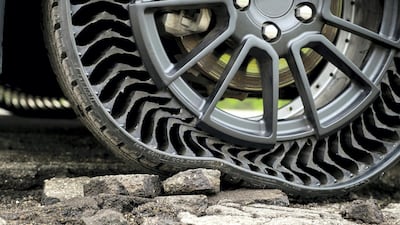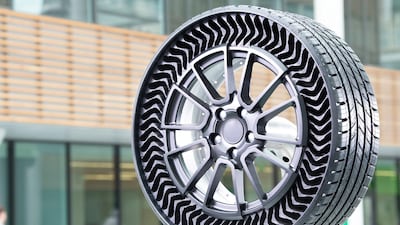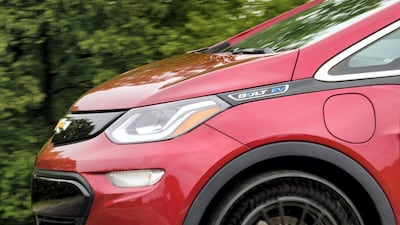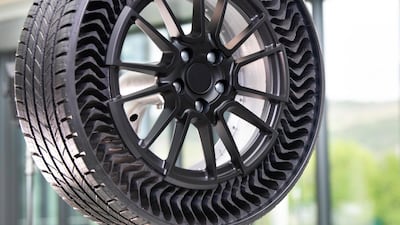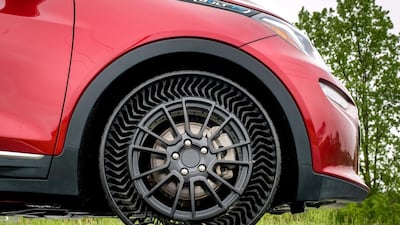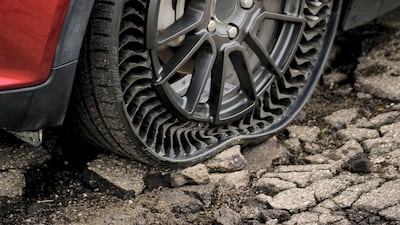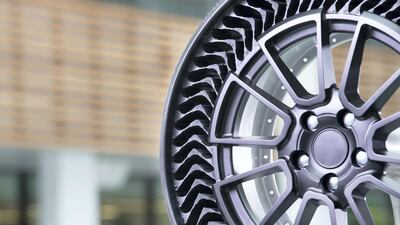Imagine there were hundreds of Burj Khalifas made entirely of rubber – and each year four were sent to a landfill. That is how many tyres Michelin say we unnecessarily throw on rubbish heaps across the world every 12 months.
Tyres that are scrapped as a result of punctures, damage from road hazards or improper air pressure causing uneven wear accounts for 200 million tyres, or two million tonnes of preventable waste, sent to landfill every year. About one billion tyres are replaced each year, while in China, the average motorist gets a puncture every six months, according to media and events company GreenBiz.
Introducing the Uptis
But Michelin claims it has found a solution in the form of a radical puncture-proof, airless tyre, called the Uptis. "The tyre of the future must be airless, 3D printed and sustainable from the use of renewable materials," Eric Philippe Vinesse, the executive vice president of research and development at Michelin, tells The National.
“Our prototype tyre already supports some of these pillars and will be available by 2024. It will deliver the same level of performance as a pressured tyre, meaning that for passenger cars there will be no more risk of flat tyres and for company fleets that translates to greater efficiency.”
The name Uptis stands for Unique Puncture-proof Tyre System and has been designed with the next phase of mobility in mind – autonomous, all-electric, shared service or other applications with which the demand for near-zero maintenance will be a priority. With the move towards the electrification of cars, the demands on tyre technology to handle the unique power characteristics of the vehicles, as well as maximising range, will force the tyre industry to reinvent itself, Vinesse says.
"As we move to EVs [electric vehicles], the expectation of the tyre is changing," he says. "The torque is much higher, so we have to design tyres to manage this. The different locations of the battery pack, whether in the floor or between the seats, also affects the balance.
"The contribution of the tyre is getting bigger in terms of energy consumption, because, when an EV is regenerating electricity, when it brakes, the difference between an efficient tyre and an ordinary tyre affects how much energy you can recover. So while an EV is not emitting carbon dioxide emissions, there's still the question of range and a very efficient tyre allows you to drive further in a car with the same battery."
How is it made?
The Uptis is made from a combination of rubber for the tread, aluminium for the embedded wheel and resin-embedded fibreglass for the 70 spokes that provide the shock absorbing properties, instead of air. After 10 years of research and 50 patents covering the structure, manufacturing and application of the spokes, Michelin says the product offers exceptional mechanical properties that are more resistant than regular pneumatic tyres.
Initially, the Uptis will be provided for general urban use and not for high-performance driving or off-roading, explains Michelin group chief executive Florent Menegaux. "In deserts with fine sand, such as in the UAE, it may create some issues, because on sand a tyre is deflated, so it can float across the top like a boat," he says. "But in this case the sand may penetrate inside and could create some balance issues. So at this stage, it's not for off-road but still covers the majority of our applications as an urban tyre."
To further improve aerodynamics and therefore gain greater efficiency, the Uptis will differ from the version Michelin unveiled in June, as the tyre will have conventional sidewalls. The prototype had open ridges around the sides when it was introduced. As such, the Uptis will look like a regular tyre, with closed side walls preventing it from collecting water and stones.
"Before we can release this to market in 2024 we require extensive co-operation from all vehicle manufacturers and real-life usage, so we can understand all the parameters before we can move to scale," Menegaux says. "It will work best on 14 to 17-inch rims (up to 43 centimetres), 18 inches at a pinch, but at this stage not on high-performance diameters of 19-inch or above.
"Part of the development programme is that you cannot replace the wheel without the 'tyre', so we are looking at the possibility of replacing only the tread. Or we may see a way to separate the centre from the spokes, but it's too soon to say."
However, Michelin is quick to point out that it's not a miracle tyre with an endless life and that the wear rate of the tread will be the same as a conventional tyre. It will still need to be replaced. It's also marginally heavier than a conventional tyre, but, as it is puncture-proof, the company says the overall weight of a car will be reduced because it will not have to carry a spare wheel, tyre, jack and tool kit. For fleet operators, it also means they will no longer have to organise maintenance programmes to check for air pressure and nails, or find a solution to the sustainability question of how to dispose of punctured tyres.
Putting Uptis to the test on race tracks
So how will the Uptis fare on race tracks, whenever it is put to the test? Scott Clark, Michelin's head of motorsport, says there is still a lot of development going into the airless tyre from this perspective.
"On the surface you could argue that motorsport and sustainability would come into conflict," he offers. "But from our position they complement each other as we are providing a valuable research and development platform for the Uptis.
"As the official tyre supplier to the all-electric Formula E championship, we have had to look at rolling resistance in motorsport for the first time, so those race cars can get the greatest range from their batteries.
"We had to develop one tyre that works perfectly in all conditions – hot, cold, wet or dry – because we don't use traditional racing slicks or specific rain tyres like in other categories. This, plus the fact our racing tyre is grooved like a road car, means what we develop on the track translates 100 per cent into our road cars and into the Uptis."
With development effectively completed, the next step is to test the Uptis on the road and Michelin is working closely with General Motors, which will begin real-world testing of the Uptis on its Chevrolet Bolt EV hatchback this year. Until then, tread lightly.
